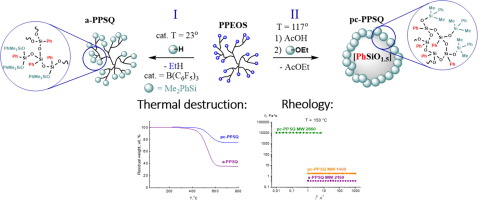当前位置:
X-MOL 学术
›
Eur. Polym. J.
›
论文详情
Our official English website, www.x-mol.net, welcomes your
feedback! (Note: you will need to create a separate account there.)
Synthesis and comparison of the rheological and thermal properties of acyclic and polycyclic forms of polyphenylsilsesquioxane
European Polymer Journal ( IF 5.8 ) Pub Date : 2020-05-01 , DOI: 10.1016/j.eurpolymj.2020.109676 Maxim N. Temnikov , Viktor G. Vasil'ev , Mikhail I. Buzin , Aziz M. Muzafarov
European Polymer Journal ( IF 5.8 ) Pub Date : 2020-05-01 , DOI: 10.1016/j.eurpolymj.2020.109676 Maxim N. Temnikov , Viktor G. Vasil'ev , Mikhail I. Buzin , Aziz M. Muzafarov

|
Abstract In this work, we present a synthesis of a non-functional acyclic form of polyphenylsilsesquioxane (a-PPSQ) by the Piers–Rubinsztajn reaction of hyperbranched polyphenylethoxysiloxane (PPEOS) with dimethylphenylsilane. The polycyclic form of PPSQ (pc-PPSQ) was obtained by hydrolytic polycondensation of PPEOS in acetic acid followed by addition of dimethylphenylethoxysilane as the blocking agent. The rheological and thermal properties of acyclic and polycyclic forms of PPSQ were compared. All the PPSQs have high heat resistance (T5% weight loss) ranging from 405 to 480 °C in air and up to 500 °C in an inert environment. The glass transition temperature (Tg) of a-PPSQ is significantly lower (−34 °C) than in pc-PPSQs where Tg = 29–104 °C for pc-PPSQs with MW = 1400–5050. It was demonstrated that both a-PPSQ and pc-PPSQ offer Newtonian flow behavior. a-PPSQ with a molecular weight (MW) of 2150 has the lowest dynamic viscosity of ~0.38 Pa*s, whereas that of pc-PPSQ with MW = 1400 is ~1.8 Pa*s (at 150 °C in both cases). With an increase in pc-PPSQs molecular weight, the viscosity increases stepwise from ~1.05 * 104 to ~2.9 * 104 Pa*s (both at 150 °C) for pc-PPSQs with MW = 2860 and 3850, respectively. The viscous flow activation energies of pc-PPSQs with MW = 2860 and 3850 are 186 and 195 kJ/mol, respectively.
中文翻译:

聚苯基倍半硅氧烷的无环和多环形式的流变学和热学性质的合成和比较
摘要 在这项工作中,我们通过超支化聚苯基乙氧基硅氧烷 (PPEOS) 与二甲基苯基硅烷的 Piers-Rubinsztajn 反应合成了一种非功能性无环形式的聚苯基倍半硅氧烷 (a-PPSQ)。PPSQ 的多环形式 (pc-PPSQ) 是通过 PPEOS 在乙酸中水解缩聚,然后加入二甲基苯基乙氧基硅烷作为封闭剂而获得的。比较了无环和多环形式的 PPSQ 的流变学和热学性质。所有 PPSQ 都具有高耐热性(T5% 重量损失),在空气中的温度范围为 405 至 480 °C,在惰性环境中最高可达 500 °C。a-PPSQ 的玻璃化转变温度 (Tg) 比 pc-PPSQ 的玻璃化转变温度 (Tg) 显着降低 (-34 °C),其中 MW = 1400–5050 的 pc-PPSQ 的 Tg = 29–104 °C。结果表明,a-PPSQ 和 pc-PPSQ 都提供牛顿流动行为。分子量 (MW) 为 2150 的 a-PPSQ 的最低动态粘度为 ~0.38 Pa*s,而 MW = 1400 的 pc-PPSQ 的动态粘度为 ~1.8 Pa*s(两种情况下均为 150 °C)。随着 pc-PPSQs 分子量的增加,分子量分别为 2860 和 3850 的 pc-PPSQs 的粘度从 ~1.05 * 104 逐步增加到 ~2.9 * 104 Pa*s(均在 150°C)。MW = 2860 和 3850 的 pc-PPSQ 的粘性流动活化能分别为 186 和 195 kJ/mol。对于 MW = 2860 和 3850 的 pc-PPSQ,分别为 9 * 104 Pa*s(均在 150 °C 下)。MW = 2860 和 3850 的 pc-PPSQ 的粘性流动活化能分别为 186 和 195 kJ/mol。对于 MW = 2860 和 3850 的 pc-PPSQ,分别为 9 * 104 Pa*s(均在 150 °C 下)。MW = 2860 和 3850 的 pc-PPSQ 的粘性流动活化能分别为 186 和 195 kJ/mol。
更新日期:2020-05-01
中文翻译:

聚苯基倍半硅氧烷的无环和多环形式的流变学和热学性质的合成和比较
摘要 在这项工作中,我们通过超支化聚苯基乙氧基硅氧烷 (PPEOS) 与二甲基苯基硅烷的 Piers-Rubinsztajn 反应合成了一种非功能性无环形式的聚苯基倍半硅氧烷 (a-PPSQ)。PPSQ 的多环形式 (pc-PPSQ) 是通过 PPEOS 在乙酸中水解缩聚,然后加入二甲基苯基乙氧基硅烷作为封闭剂而获得的。比较了无环和多环形式的 PPSQ 的流变学和热学性质。所有 PPSQ 都具有高耐热性(T5% 重量损失),在空气中的温度范围为 405 至 480 °C,在惰性环境中最高可达 500 °C。a-PPSQ 的玻璃化转变温度 (Tg) 比 pc-PPSQ 的玻璃化转变温度 (Tg) 显着降低 (-34 °C),其中 MW = 1400–5050 的 pc-PPSQ 的 Tg = 29–104 °C。结果表明,a-PPSQ 和 pc-PPSQ 都提供牛顿流动行为。分子量 (MW) 为 2150 的 a-PPSQ 的最低动态粘度为 ~0.38 Pa*s,而 MW = 1400 的 pc-PPSQ 的动态粘度为 ~1.8 Pa*s(两种情况下均为 150 °C)。随着 pc-PPSQs 分子量的增加,分子量分别为 2860 和 3850 的 pc-PPSQs 的粘度从 ~1.05 * 104 逐步增加到 ~2.9 * 104 Pa*s(均在 150°C)。MW = 2860 和 3850 的 pc-PPSQ 的粘性流动活化能分别为 186 和 195 kJ/mol。对于 MW = 2860 和 3850 的 pc-PPSQ,分别为 9 * 104 Pa*s(均在 150 °C 下)。MW = 2860 和 3850 的 pc-PPSQ 的粘性流动活化能分别为 186 和 195 kJ/mol。对于 MW = 2860 和 3850 的 pc-PPSQ,分别为 9 * 104 Pa*s(均在 150 °C 下)。MW = 2860 和 3850 的 pc-PPSQ 的粘性流动活化能分别为 186 和 195 kJ/mol。











































 京公网安备 11010802027423号
京公网安备 11010802027423号